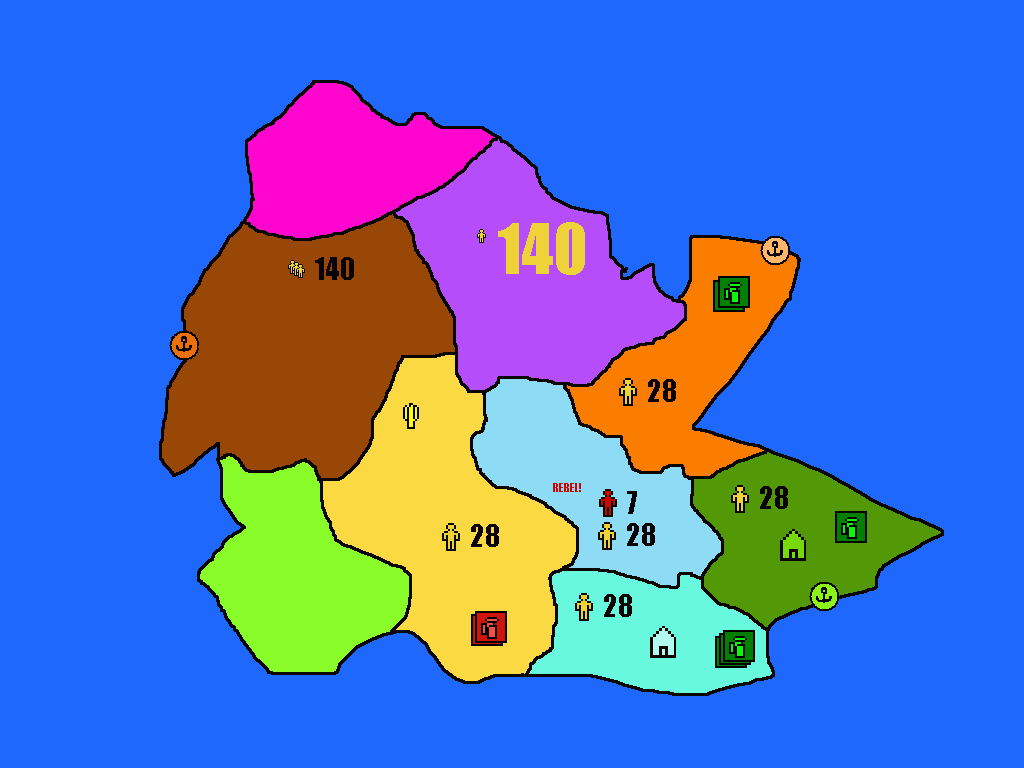This topic is about my prototype of a turn based strategy game that was simulating industrial revolution. I posted here a post mortem, but I also would like to get your ideas how to redo/fix it, since I like this project. So any comments are highly welcomed ![]()
Overview
The prototype was a turn based, very small and cozy strategy game of industrial revolution period. You had 16 provinces (an island), no enemies, no combat, just economy/infrastructure/trade.
The core mechanic was factories and resources transformation. For example you first built coal mine and iron mine, then foundry to make steel ((5 coal + 5 iron = 5 steel )* numer of foundries), then you could use steel to produce other things. There were many other formulas like this (wood to planks OR paper; wood to textiles; clay to bricks).
Each province had population, it was providing labour to factories and consumed food (they key was to improve agriculture via fertilizers and machines so you could free farmers and convert them to labourers and to get a population boom).
What went wrong
1) The biggest fail was province level factories/mines. You were building factories in provinces, but the resources were country wide. I made 2 reasons to make province selection important. First, was the transport cost, the resources were to be transported (invisible to the player! another not so great idea) to other provinces (so you wanted to build a foundry in a provice that had coal and iron mine). The second reason was wages; the wages paid to labourers were based on unemplyment/overhours, so you wanted to spread your factories more or less evenly.
But... as a player I noticed I really wanted the information how many coal mines I have GLOBALLY compared to my iron mines GLOBALLY and foundries GLOBALLY. So when building inside a province I was always looking to the country global stats. I even dispalyed two numbers next to each mine/factory how many of these I have locally (in province) and how many in the whole country. It sux, big ![]()
2) Next problem was the provinces identification, I could not get to rememebr what I have where ![]() But, that's maybe there was no map yet, just a dropdown list with province names.
But, that's maybe there was no map yet, just a dropdown list with province names.
3) Next one was pointless localization of provinces. Yes, this was this (hidden) auto transport of goods thing, but other than that it made no difference where each province was located (neighbours).
4) The last mistake, I think, was the cleanliness of resource system. I insisted on fixed 1 coal + 1 iron = 1 steel (s the player can instantly calculate how many mines he needs to build to assure flawless enonomy). Which made all improvements like efficiency technologies impossible (other than by big steps) and what worse all factories always had the same efficiency no matter the labourers (labourers availability only affected the wages costs - if there was a shortage of workers you simply paide much more). I also insisted on no fraction of resources (like 0.95 coal) which probably was a mistake...
What went right
The theme was great, I really liked it. The resource system (coal+iron=steel), even through had flaws in implementation, was very nice, it felt like an industrial era.
How would I do it now
First, I would make it less clean and take away from the player some control. There is no need for a player to be able to calculate everything precisely, approximation is all right. Maybe even some randomness (in mines capacity for example) or delays in production, generally, a bit less predictability how many units of toilet paper your industry will make next turn ![]() Just a clear understanding of general direction is sufficient (this would also cut down on boring micromanagement).
Just a clear understanding of general direction is sufficient (this would also cut down on boring micromanagement).
Next I would discard the artificial systems that were supposed to give some significance to provinves localization, like transport of resources. It was complex, messy, hidden from the player and generally did more harm than good. Instead I probably would make some factory slots in provinces or other purely local stuff.
And above all, I would much earlier implement a map, like that one ![]() And I would allow putting some tokens on provinces (on the main map, not from inside the province). These things simply look tasty
And I would allow putting some tokens on provinces (on the main map, not from inside the province). These things simply look tasty ![]()
(it's just a draft of a map, don't try to find a logic why each province has different icons, I was just testing what icons/font sizes would look best)







